#asimina parviflora
Text
Was trekking through the woods and I think I found a Smallflower Pawpaw (Asimina parviflora)?? I can’t be at 100% certain because I didn’t know that it existed until Inaturalist identified it! Have some pics!

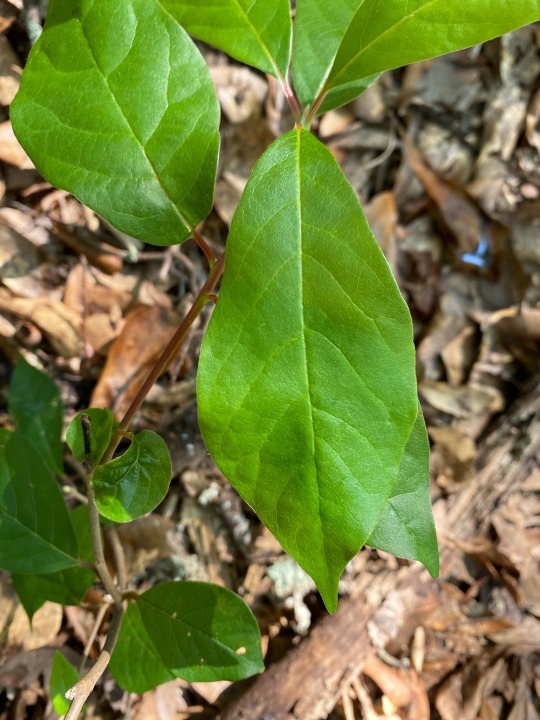
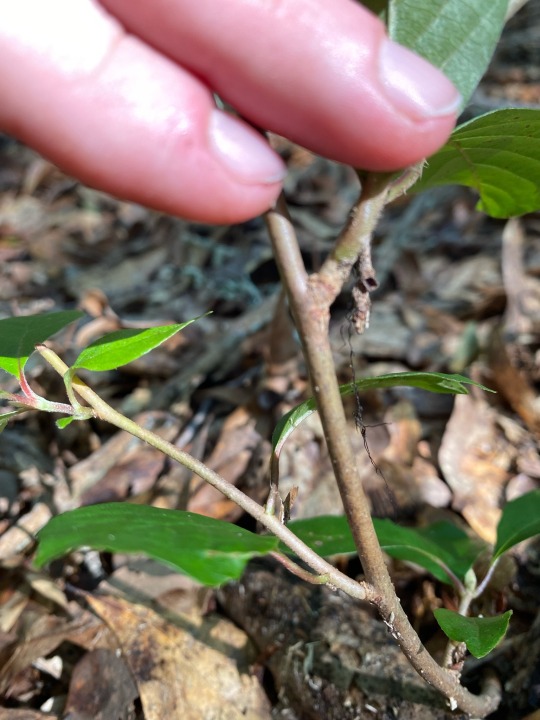

I looked it up and it seems to match up pretty well, but to me it just looked like a young black tupelo + all the plants surrounding them were black tupelos
EDIT: the bright green leaves were new growth, it appears this guy was a snack for something at one point, the older growth was a deeper green
16 notes
·
View notes
Text
>:D small-flower pawpaw fruit created with pollen from a common pawpaw!


[ID: Two photos taken with flash, showing tiny green fruits just starting to form on two small-flower pawpaw stems, with a hand in the background for scale. The fruits are tiny and pale green, shaped like little clusters of bananas. They are growing on dark brown twigs with green new growth at the top. In the second photo, a green flower is still growing below the fruits, with three longer petals hanging down like a skirt. End Id.]
#Rjalker trains its gardening skill#asimina parviflora#asimina triloba#pawpaws#asimina#small-flower pawpaw#small flower pawpaw#smallflower pawpaw#pawpaw#pawpaw tree#pawpaw fruit
3 notes
·
View notes
Text
Test your small-flower and common pawpaw identification skills!
Link to the identification guide I made, on the web archive.
Link to the identification guide on google docs.
You are encouraged to download it and save for later. You are also encouraged to check with the guide while looking at the pictures below to figure out which species they are.
This is to see whether or not the guide I made can actually help people tell the various species I talk about in it apart, since I obviously can't test myself!
Please let me know of any suggestions or improvements I could make to the guide :)
Here is the quiz! If you want to see if you got it right, you can click on the link to the observation above each photo!
The multiple choice answers will just be in the same order each time because I'm lazy lol.
To repeat: You are supposed to use the guide while you look at these--it's supposed to be something you take out to the woods with you, there's no such thing as cheating!
======
#1:
Observation by kent_ozment, September 14th

[ID: A photo of a plant with large leaves with smooth edges and a bumpy texture. End ID.]
A: Common pawpaw
B: Small-flower pawpaw
C: Hickory
D: Persimmon
E: Other
======
#2:
Observation by nonbinary-naturalist September 21st

[ID: A photo taken at night with flash turned on, of a plant with deep green, smooth leaves. The stem is light brown, with a slightly pointed bud at the tip, and round buds at the base of each leaf. Some small white spots dot the leaves in a few spots. End ID.]
A: Common pawpaw
B: Small-flower pawpaw
C: Hickory
D: Persimmon
E: Other
======
#3:
Observation by elacroix-carignan, June 25th

[ID: A photo of a cluster of three fruits on a tree. The fruits are green with reddish-tinted edges, and small, with lumpy centers and pointed ends. The leaves are smooth. Part of the stem is grey with some moss on it, part is warm brown. Spanish moss hangs in the background. End ID.]
A: Common pawpaw
B: Small-flower pawpaw
C: Hickory
D: Persimmon
E: Other
======
#4:
Observation by nonbinary-naturalist, September 25th

[ID: A photo of a plant with a white hand held behind the stem. The stem is red-brown, the leaves are smooth, and have yellow veins in the center, which turns red when it connects to the stem in long sections. The buds at the base of each leaf are dark and pointy. End ID.]
A: Common pawpaw
B: Small-flower pawpaw
C: Hickory
D: Persimmon
E: Other
======
#5:
Observation by nonbinary-naturalist August 13th

[ID: A zoomed in photo of the stem of a plant. The stem is orange colored near the top, and the leaves are green, smooth, and have yellow veins in the center which turn yellow and orange when they connect to the stem in short sections. End ID.]
A: Common pawpaw
B: Small-flower pawpaw
C: Hickory
D: Persimmon
E: Other
======
#6:
Observation by nonbinary-naturalist, April 28th
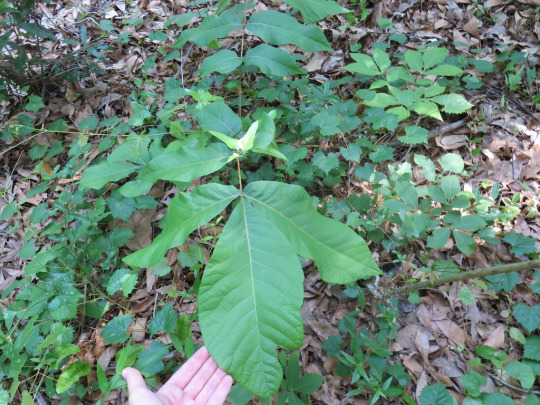
[ID: A slightly blurry photo of a white hand holding up a large, wrinkly leaf on a small sapling. The leaf is very large, and has two smaller leaves at its base pointing to the sides. The ground in the background is covered with brown dead leaves and wild muscadine grape vines. End ID.]
A: Common pawpaw
B: Small-flower pawpaw
C: Hickory
D: Persimmon
E: Other
======
#7:
Observation by thorlovescake, August

[ID: A photo of a hand holding the tip of a leaf from a stem. The leaf is smaller than the hand, green, smooth, and shaped like an oval. Several more leaves hang down near it, emerging from the tip of the brown stem, which has a rounded, dark bud at the top. Some small black spots are scattered on the leaves. Where the leaves connect to the stem, they are round and pale yellow. End ID.]
A: Common pawpaw
B: Small-flower pawpaw
C: Hickory
D: Persimmon
E: Other
======
#8:
Observation by onondagaearthcorps, October 10th
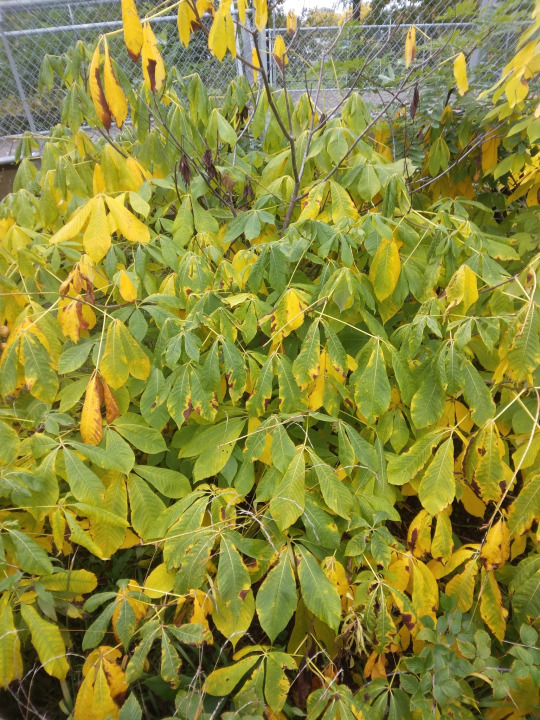
[ID: A photo of a large plant with its leaves all pointing towards the ground, and changing from green to yellow with the fall. The leaves are wrinkly, serrated, and are in groups of five at the end of a long section attaching it to the stem. End ID.]
A: Common pawpaw
B: Small-flower pawpaw
C: Hickory
D: Persimmon
E: Other
======
You can either just click the Observation link to see how well you did yourself or submit your answers in an ask, with the question's number, then the letter you chose, and I'll grade you and explain anything you got confused on :)
#long post#described images#plant identification#pawpaws#asimina#asimina parviflora#asimina triloba#diospyros virginiana#carya#Aesculus hippocastanum#aesculus#diospyros#Nyssa#Nyssa sylvatica#tupelos#tupelo#hickory#persimmon#pawpaw#horse-chestnuts
2 notes
·
View notes
Text
Two small-flower pawpaw plants at Mohawk Park, Savannah, Georgia.
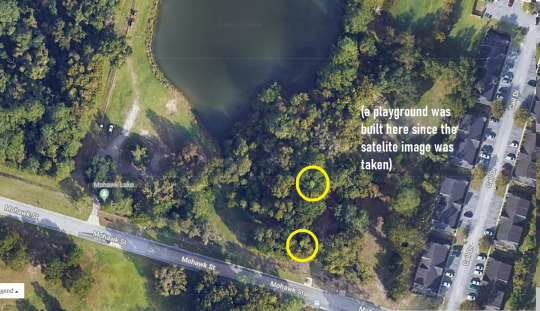
[ID: A satelite view showing part of a lake marked “Mohawk Lake”, with a stand of trees on either side, with the trees on the right marked with two yellow circles around green markers. White text in a small clearing notes, “(A playground was built here since the satelite image was taken) End ID.]
The first one, which is easier to get to and more obvious, is in the little separate path of trees that separates the playground and field from the road. It’s on the side facing the playground, and very bushy, with at least three stems, and looks like it should flower in 2022.
https://www.inaturalist.org/observations/87320372

[ID: A photograph of a small-flower pawpaw plant standing amidst many other plants, with many bushy, dark green and smooth leaves pointed upwards. End ID.]
The second one is smaller and might be harder to see, it’s further into the woods (like 10 feet or so). I put some logs around it to make it easier to see (after I took the picture).
https://www.inaturalist.org/observations/87320370
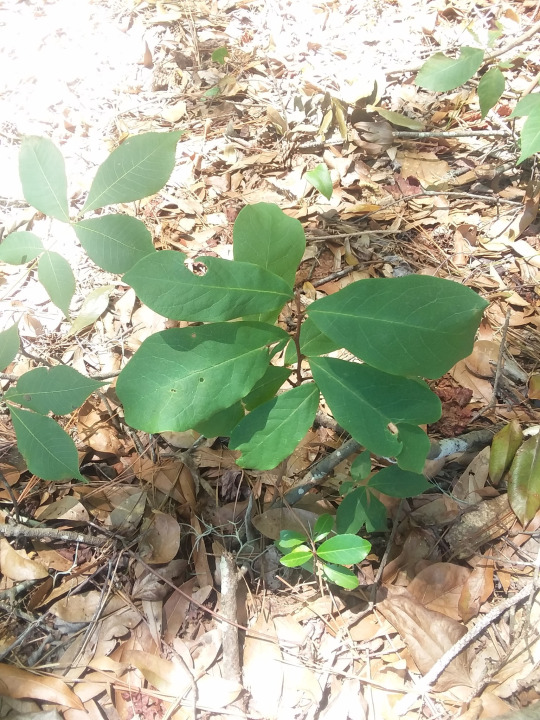
[ID: a photograph of a small-flower pawpaw against the first floor, standing upright with its dark green, smooth leaves facing towards the camera. A smaller vine grows beneath it, and a young hickory grows off to the side. End ID.]
#plant locations#Savannah georgia#mohawk lake#mohawk park#pawpaws#pawpaw#paw paw#asimina#Asimina parviflora#smallflower pawpaw#small-flower pawpaw#georgia#georgia native plants#host plants#georgia host plants
6 notes
·
View notes
Text
literally started jumping up and down and screaming in excitement when I realized my cross pollination between the common and small-flower pawpaws worked!!!!!
There's at least 5 baby fruits forming from two flowers I pollinated last week, and I just finished pollinating three more which will also hopefully form fruit!!!!!!!!!
The seeds of which will produce the hybrid, Asimina x piedmontana!!!!! Which I will then be able to study in detail and most importantly, take public domain photos of for everyone to learn from!!!!!!!!!!!!!!!!!
#Rjalker trains its gardening skill#Asimina x piedmontana#Asimina piedmontana#Asimina triloba#Asimina parviflora
3 notes
·
View notes
Text
Anyways since I already forgot I literally did publish a book:
Here's where you can buy a physical copy of my Small-Flower Pawpaw Identification and Differentiation guide!
It shows you how to tell small-flower pawpaws apart from common pawpaws, and a few other similar looking species!
Here's a map of observations of small-flower pawpaws, as of December 7th, 2022, from iNaturalist.org. As of today there's 1,703 observations :)

[ID: a cropped satelite view of North America showing an area from Texas to North Carolina to Florida. Scattered over this area are orange boxes in various densities. End Id.]
Each orange box represents an observation! And if you're within this area but don't see any near you, don't dismay, it probably just means no one uses iNaturalist in your area, so you can be the first one to start posting observations!
[ID: A link preview for Lulu.com showing a small-flower pawpaw plant, with text overlaid that reads, "Small-flower pawpaw Identification and Differentiation Guide". End ID.]
Here's the web archive page for it where you can download it in various formats for free: Link Oh! and it looks like you can read it there too? Nice!
And here's the link to the google doc which you can also download for free!
This guide is public domain because I wanted it to be available to everyone possible! :) That means you can download and share the files as many times as you want in any way you want! If you know how to bookbind (and have lots of printer ink, lol) you can even print it out and make your own physical copies!
If you live in or are visiting Atlanta, Georgia, congrats! Small-flower and common pawpaws can both be found there, so especially if you're there when the fruits are ripe, you might get extra lucky and be able to find both!
#books#free books#plant identification#pawpaws#asimina#asimina parviflora#asimina triloba#iNaturalist#Nature#Wildlife#Wild plants#foraging#wild edibles#edible plants#edible fruit#Lol#Atlanta Georgia
23 notes
·
View notes
Text
look at all these baby fruits. this is gonna look hilarious. every one of those green things inside the flower is gonna turn into a fruit.

[ID: A photograph of a white hand holding a small-flower pawpaw flower that has started to develop fruit inside, with eight young fruits visible, sticking out of the center of the flower like tiny green bananas. End ID.]
3 notes
·
View notes
Text
the plant phenology graph for small-flower pawpaws as of March 13 2023, with 1,769 observations.
orange = flower budding
red = flowering
blue = fruit actively on the plant
green = not flower budding, flowering, and no fruit still on the plant.
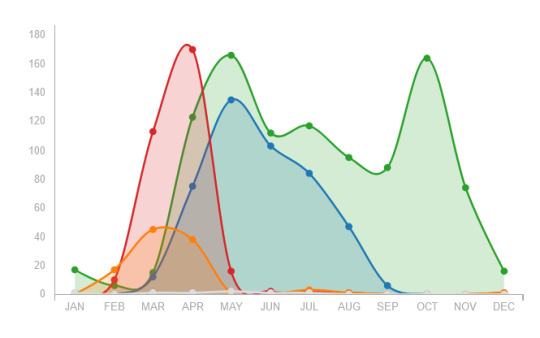
the orange line becomes visible again in July and August because sometimes if they get cut down or damaged they'll flower again, I assume because they think, "this is it, I'm dying, I must have babies or we'll go extinct". have not seen then successfully form fruit from these flowers, though, since they can't pollinate themselves.
and the graph for common pawpaws, Asimina triloba, so far, still not done, obviously. Same key as above, with grey meaning "No data recorded" because I haven't gotten to those ones yet, and most people don't add annotations.
21,114 observations total, including the grey line.

notice how they're both offset by a month, the small-flower pawpaw starts flowering a month earlier, and stops fruiting a month earlier.
#undescribed images#small-flower pawpaw#dwarf pawpaw#asimina parviflora#pawpaws#asimina#asimina triloba#pawpaw#common pawapaw
2 notes
·
View notes
Text
11,760 + more every day to go!!!!!!

[ID: A screenshot from the Nickelback music video for the song Photograph, with meme text over head now reading, "Look at this graph", with the picture frame overlaid with a line graph showing the behavior of plants in the genus Asimina over the course of the months of the year.
T the colors of the lines are marked: green = no evidence of flowering, red = flowering, blue = fruiting, orange = flower budding, and grey = no annotation. Most of the graph is filled out, except for two large high points of grey in May and October, with a lower section between.
At the bottom corner of the image is text that reads, "iNaturalist Asimina graph March 4th 2023".
End ID.]
Link to the graph which will keep being updated. Click "plant phenology" to see it :)
"https://www.inaturalist.org/taxa/50900-Asimina"
2 notes
·
View notes
Text
Since these two species get confused for eachother often, and since I happened to take almost identical pictures of each plant, here's a little tutorial on how to tell them apart.
Common persimmon. observation on iNaturalist. July 19th 2022.
Key features: Distinct leaf-stem turns pink or red at base, central leaf vein is yellow. Leaves are light green and rounded at base. Twig is grey-brown, with dark, cone-shaped buds are the base of each leaf.

[ID: A photograph of the end of a common persimmon stem, with a white hand behind it for contrast and scale. The leaves are light green and rounded at the bottom, with their main leaf-veins light yellow, and the stem holding them onto the twin a reddish-purple or pink. The stem is grey-brown, with dark, pointed buds at the base of each leaf, which alternates up the stem in a zig-zag pattern. End ID.]
-
Small-flower pawpaw. Observation on iNaturalist. July 7th, 2022.
Key features: Leaf-stem appears to fold onto twig rather than having a distinct leaf-stem, and is yellow-green with a brown center. Central leaf vein is green-yellow. Leaves are dark green and pointed towards base. Twig is warn brown or cinnamon, with matching colored round buds at base of each leaf, and a small pointed brown bud at the very end of the stem next to the newest leaf.

[ID: A photograph of the end of a small-flower pawpaw stem, with a white hand behind it for contrast and scale. The stem is cinnamon brown, with dark green leaves with round buds at their bases, and a pointed bud at the very end of the leaf. The main leaf vein on each leaf is light yellow-green, and the stem is spotted with a few small light specks. The leaves alternate up the stem in a zig-zag pattern. End ID.]
-
Other ways to tell them apart: Is it fruiting? Common persimmons form actual proper trees, so the fruit will be way over your head unless it's kept short artificually. Pawpaws on the other hand can and will fruit when they're less than a foot tall. If the plant is shorter than you are and has fruit on it, it's probably a pawpaw.
You can also tell them apart by what the fruit looks like -- pawpaw fruit starts out green and it'll stay green until it starts to rot and turn first yellow, then black. It comes in a few shapes, but they're usually sort of curved, like a fat banana.
Persimmons on the other hand will be found, with very distinct four petal-things on the top like a crown.
Pawpaws have smooth bark, and persimmon bark as they age gets very craggy.
#common persimmon#Diospyros virginiana#plant identification#persimmon#persimmons#pawpaws#small-flower pawpaw#dwarf pawpaw#asimina parviflora#Rjalker trains its gardening skill#Rjalker does iNaturalist#described images#plants#wildlife#georgia native species#georgia native wildlife#georgia native plants#georgia native fruit plants#georgia native fruit trees#are small-flower pawpaws trees???#I think they're shrubs#I have yet to see one taller than me in person. so
4 notes
·
View notes
Text
alright. anyways.
Here's where you can download the small-flower pawpaw identification and differentiation guide for free: Link to Archive.org
And here's where you can buy a physical copy for as cheap as the site will let me list it. I meant for it to only cost however much they need to print it, but I can't figure out how to do that since it says it's already set to the lowest price. So I guess I'm gonna make $8 profit from each book even though I intended to get 0. Someone tell me how to change this I want it to be as cheap to buy a possible. I'd rather more people be able to buy it than me getting paid for it. Link to Lulu.com
anyways yeah. have fun. Download it for free, give it to your friends for free, print it out and staple it together if you want. Make your own books if you know how to bind books.
#?????? WHY WON'T THEY LET ME LIST IT FOR PRACTICALLY FREE :(#I DON'T WANT MONEY FOR IT I WANT IT TO BE AS CHEAP AS POSSIBLE SO MORE PEOPLE CAN BUY IT!!!! D:<#pawpaws#common pawpaw#asimina#asimina parviflora#asimina triloba#iNaturalist
3 notes
·
View notes
Text
Observation of a Small-flower Pawpaw by Safron on iNaturalist

[ID: A photograph from above of a small-flower pawpaw plant, with a light colored hand behind the stem for scale.
The leaves are medium green, and small, most of them able to fit into the palm of the hand shown. They are very uniformly teardrop shaped, with a very narrow base where they attach to the stem, and an evenly rounded end, which is the widest point. Some of the veins on the leaves cause the surface to ripple slightly, but other than that, the surface of the leaf is smooth.
A few leaves have holes chewed through them by insects. The ground below them is covered in fallen pine needles, with a small grape vine visible crawling along the ground.
End ID.]
By far the weirdest little small-flower pawpwaw I've seen yet. These leaves are literally just perfect little teardrops. They are so short and small and round. This is such a weird little pawpaw, and despite the odd shape of the leaves, it is unmistakable Asimina parviflora. There is no doubt about that.
This is why I love plants. You might think just from a glance that all plants of the same species are the same, but they're not. They each have their own unique characteristics, even if they're subtle.
I saw this clearly when I was growing common milkweed from seed up in Pennsylvania - each seedling, as it matured, had distinctive differences in the shapes and size of their leaves, the pattern of the veins on the leaves, their flower color, and the shape of their seed pods! MTR's were abnormally skinny, Julia's were very large with big "spikes", and Goth Kid's were very round with closely packed "spikes".
And the common persimmon seedlings I have this year, each of them have their own differences. One of them I even named Red because of how starkly red the base of the leaf is, while the others, all siblings from the same parent tree, have veins in shades of bright or soft yellow, one of them so light it's almost white!
Plants are unique, diverse individuals just as much as any animal, and that's just amazing. I guarentee you that if you took leaves off of each of my common milkweed plants from Pennsylvania and showed them to me, I'd be able to tell you which one came from which plant.
Grow plants from seed and see for yourself!
If you're in Common milkweed's native range, grow that! Check iNaturalist to see if there are any plants near you if you don't have any seeds! A single seed pod should give you enough to last a life time, if you save seeds from the plants you grow!
And if there aren't any near you and you don't have money to buy them...Let me know, lol, I might be able to help. We now live in Georgia, just a bit too far south for common milkweed's natural range, so I have literally thousands of seeds that I saved, that I am happy to share, as long as you're inside its natural range.
2 notes
·
View notes
Text
O:
I got a picture of a spider and didn't even notice!!!
look at this little cutie!!!

[ID: A picture of a white hand holding onto the stem of a small-flower pawpaw, which has dark green leaves and a warm brown stem, with rounded buds at the base of each leaf, and a pointed leaf bud at the end of the stem.
On the leaf near the thumb is a very small, light green spider. End ID.]
#spider photos#spiders#Rjalker takes pictures#bugs#insects#shh#I am aware they are not insects#arachnids#asimina parviflora#pawpaws#small-flower pawpaw#dwarf pawpaw#georgia native plants#described images
2 notes
·
View notes
Text
Anyways if anyone wants to see my very work-in-progress guide on how to identify small-flower pawpaws and tell them apart from other things, here's the link. It's a WIP being written in random order so I'm jumping around a lot adding things, so it might start changing while you're reading it lol.
When it's done it'll be free for anyone and everyone to save, download, share, print, whatever. If Lulu.com lets you print books with pictures, I'll also set it up so you can buy a physical copy from there with you only paying however much they need to manufacture it, like how Stone Butch Blues is set up.
Why? Because fuck capitalism, that's why, and because I want people to know about plants and know how to identify them and I don't think people should have to pay money to learn stuff that I'm happy to teach for free.
You can download it if you really want to as it is right now, but obviously it's not done yet. (Unless you're reading this post in like, 2030 or something, it's probably done by then lol.)
1 note
·
View note
Text
once again all of the genus Asimina (aka pawpaws) on iNaturalist have plant phenology annotations.

1 note
·
View note
Text
:)
You can buy a physical copy of my American Persimmon Identification Guide here from Lulu.com!
You can also read and download it for free on the web archive!
and:
Here's where you can buy a physical copy of my Small-flower pawpaw identification guide, which shows you how to identify Small-flower and common pawpaws, as well as a smaller guide on American persimmons and hickories :)
And you can read and download this for free from the web archive too!
#free books#unless you want a physical copy#American persimmon#common persimmon#wild edibles#foraging#Common persimmon#Small-flower pawpaw#Common pawpaw#asimina#asimina triloba#asimina parviflora#diospyros#diospyros virginiana
1 note
·
View note